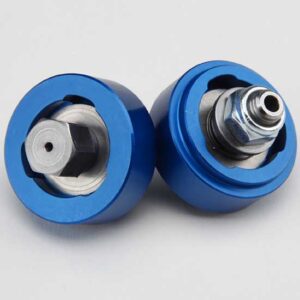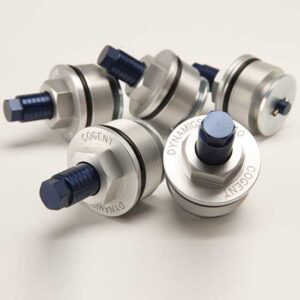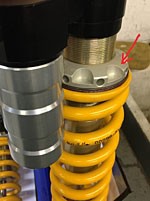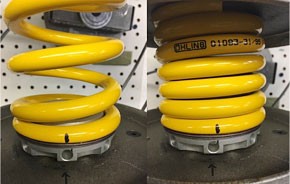- Home
- Sale!
- Shop
- Featured
- Featured Products
-
 DDC (Drop in Damper Cartridge) for the Yamaha TW200
0 out of 5$232.95
DDC (Drop in Damper Cartridge) for the Yamaha TW200
0 out of 5$232.95 -
 Complete DDC kit for the Yamaha TW200
0 out of 5$379.95
Complete DDC kit for the Yamaha TW200
0 out of 5$379.95 -
 Kawasaki KLR650 Adjustable Fork Caps Gen One 1987-2007
0 out of 5$208.95
Kawasaki KLR650 Adjustable Fork Caps Gen One 1987-2007
0 out of 5$208.95
-
- Featured Products
- About
- Service
- Bikes
- Resources
- Contact
When forks are serviced or worked on, there are variables that can be difficult to account for. Some of the important variables are the efficiency of draining the old oil and the displacement of replacement springs. Oil height variation is an important tuning tool which affects the wheel rate (spring rate at the wheel) predominately during the last third of the travel. Small changes can make a big difference to the ride performance and the level should be accurately measured after the fork is bled and free from entrapped air.
 Cogent Dynamics replacement shocks are built to the same length as your OEM shock (unless you requested a special modification in the build) and what you notice is the difference in rider sag. The rider sag should be the same for either and setting your sag by adjusting the preload adjuster collar will correct the issue.
Cogent Dynamics replacement shocks are built to the same length as your OEM shock (unless you requested a special modification in the build) and what you notice is the difference in rider sag. The rider sag should be the same for either and setting your sag by adjusting the preload adjuster collar will correct the issue.
Keep in mind, you may not have been running the correct rider sag with your previous shock. An example would be if you were running 50% sag or say 4” when more like 35% is suggested, say 2.75”. In that example, your bike would be riding 1.25” taller than it was even though the shocks are built to the same length specification.
On many bikes, a loaded sag setting would be at about 35% of the rear suspensions full extended length. This is a good starting point but it is perfectly fine for a customer to use a setting somewhat different than the recommended setting, in order to better suit his or her needs. If you have special requirements, contact Cogent Dynamics for a custom setup.
If you haven’t done this yet, reduce the preload on the spring by turning the spring seat collar counter clock-wise as viewed from the top of the bike by about 2 full turns. Use the pin spanner tool we sent with the shock. You could take an additional 2 or even 3 turns out but don’t do more than the total of 5 turns as that would under preload the spring. Congratulations on the need (assuming it is a desired weight loss). I sure wish I needed to reduce my preload by a similar amount!
The needle thrust bearing is an optional component that is inserted between the spring perch (usually the threaded spring adjuster collar) and the shock spring and serves to reduce the friction between the perch and the spring. The reduced friction allows for easier adjustment of the spring preload, significantly reducing the force it takes to rotate the threaded collar. An added benefit is that there is a smoother spring action due to the twisting moment the spring exerts when it becomes compressed. While the exact amount of rotational movement is dependent on the amount of spring compression and design, it would be fairly typical to measure 4-5 degrees of rotation for a 4” compression of the spring.

The mark displacement indicates spring twist on compression.
The Remote Preload Adjuster gives you a very easy to adjust means of changing your spring preload, likely the most important adjustment on your suspension. The preload adjustment is really important with widely variable loads. The correct spring rate is a key element but there is no way to have the exactly correct rate for your loaded and unloaded conditions of use. The stock DR shock provides the capability for changing preload, as does (in a more convenient way) the standard Mojave shock.
Take a peek at this page, at the bottom you can see the implementation of the Remote Preload Adjuster: https://www.motocd.com/suzuki-dr650-suspension-upgrades/
Keeping in mind, changing preload is not the same as making a spring softer or harder. In effect, you are leveling the bike or correcting the sag, an EXTREMELY important suspension setting. The suspension needs to operate in the correct range.
Excessive preload causes a high rear ride height and topping out of the suspension causing poor ride characteristics and potentially damaging your suspension system. If the adjustments are difficult to make, it is possible (if not likely) that they will not occur as needed. The Remote Preload Adjuster https://www.motocd.com/product/remote-preload-adjuster-for-cogent-shocks/ will make the adjustments easy and convenient so that in a changing load environment like yours, the adjustments will happen, enhancing the bikes performance and riders experience.
I find that for me, having east access to the adjustment means I even dial in changes based on ride conditions, road vs sandy trails are good examples. The adjustment is useful even when load changes are not in the equation.
For your conditions, I would recommend a the correct rear spring with the minimum preload set at 5mm and a maximum preload of 15. That’s going to cover a lot of ride conditions.
The Cogent Remote Preload Adjuster is not available to fit the stock DR body. The “Bling Ring” with bearing would give some of that same benefit by easing the trouble that the stock preload adjusters are.
Adjustments for Cogent and other shocks: https://www.motocd.com/motorcycle-rear-shock-adjustment/

